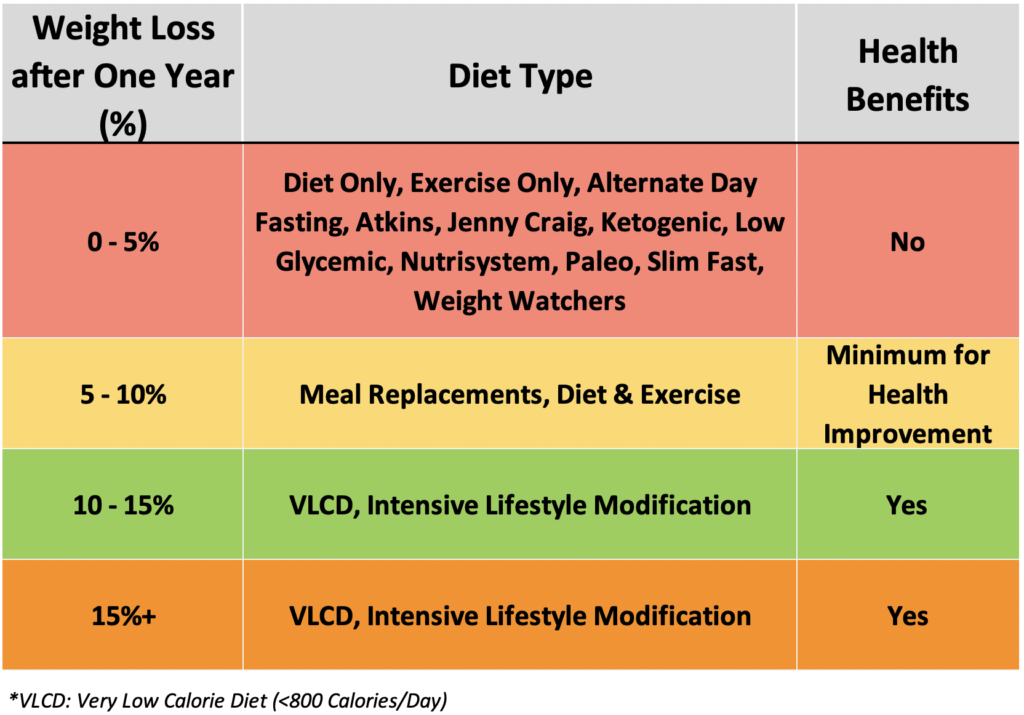How many commercials have you seen for a weight loss program showing before and after pictures of an obese individual losing 150 pounds and becoming ripped? This all too familiar strategy to promote weight loss products and services shouldn’t be allowed. It is false advertising and only represents the absolute best-case scenario at the very lowest point in their (unsustainable) weight loss.
In reality even the very best weight loss programs typically only result in a 15-20% weight loss after one year (Table 02.1).

Unless you weigh 500 pounds, it is unlikely that you will lose the amount of weight portrayed by the weight loss companies. If you do weigh 500 pounds, then it is very realistic to lose 100 pounds (500 – 100 = 400; 20% weight loss) but you’re still not going to be happy with that.
Research has shown that people with obesity tend to want to lose 25 – 35% of their body mass during a one-year weight loss program. This just isn’t realistic.
To give you further insight into the expectations people have for weight loss, we’d like to cite a classic study from Foster et al. In this study 60 people with obesity were assigned to a low-calorie diet, exercise, and behavior modification training for a total of 48 weeks. At the beginning of the study, 24 weeks, and 48 weeks they were asked to rate their weight loss outcomes on the following scale.
Dream Weight: “A weight you would choose if you could weigh whatever you wanted”
Happy Weight: “This weight is not as ideal as the first one. It is a weight however, that you would be happy to achieve”
Acceptable Weight: “A weight that you would not be particularly happy with, but one that you could accept, since it is less than your current weight:
Disappointed Weight: “A weight that is less than your current weight, but one that you could not view as successful in any way. You would be disappointed if this were your final weight after the program”
Zero percent of people achieved a dream weight at 48 weeks, 9% reached a happy weight, 24% an acceptable weight, and over two-thirds reported being either disappointed or miserable (Table 02.2). And it is not as if the program was a failure. On average, the participants lost 37 pounds at the end of the study, which was a ~17% weight loss. But this illustrates the gulf between expectations and realities.

We’re not trying to dissuade you from trying to lose weight but we want to be honest and transparent about the realities of weight loss and just how difficult it is. The amount of weight loss the weight loss companies are portraying in their ads is not impossible but it just isn’t likely. You need to be the exception to the norm to lose that type of weight.
We will talk about this in more detail later (Section 11), but it is also worth mentioning that the greatest amount of weight lost after one year is on a very low-calorie diet (VLCD), which by definition is a diet with less than 800 calories/day (Table 02.1). Weight loss companies tend to portray their diets as easy. Just cut out carbs or just eat meal replacements but the reality is that just cutting out calories isn’t going to lead to the type of results many of you are seeking. This is why we recommend going on a VLCD (with physician supervision) or at the very least going on a low-calorie diet (LCD), which is 800 – 1200 calories/day.
Read Next: Section 03: There are No Shortcuts